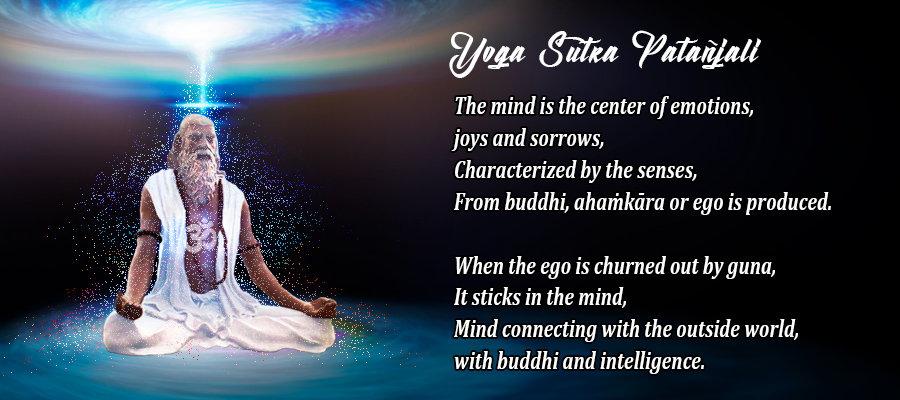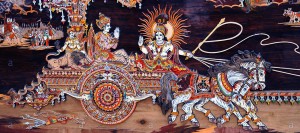Samkhya occupies himself by way of reasoning to achieve liberation, especially concerning himself with the analysis of manifold material from the Prakriti from which the Purusha must draw out, and Yoga more on the path of meditation focusing attention on the nature of mind and consciousness, and concentration techniques to provide practical methods. Sāṁkhya seems to be the earliest philosophical system formed in the late Vedic period, and has permeated almost all subsequent Hindu traditions; indeed the Patañjali classical Yoga has been seen as a type of neo-Sāṁkhya, renewing the old Sāṁkhya tradition to bring it into conversation with the more technical philosophical traditions that had emerged in the 3rd to 5th century AD, especially Buddhist thought. In fact, Samkhya and Yoga should not be considered as different: the first reference to Yoga seems to be different in the writings of the 9th century Sankara Yoga and Sāṁkhya in Upaniṣad and Epic only refer to two different paths of salvation through meditation and salvation through each other’s knowledge.
One might add, in addition to that of the 900-references to Yoga at Mahābhārata, there are only two mentions of āsana, the posture of the limbs of the third body of the Patañjali system. Both Upaniṣad and Gītā do not mention postures in the sense of stretching and body pose exercises (this term is used as “seat” rather than body posture), and Patañjali himself only dedicates three brief sūtra from his text for this aspect of the practice.
The configuration, presentation, and perception of Yoga as the main or even exclusive āsana in the sense of body poses are basically modern Western phenomena and do not find precedents in the premodern Yoga tradition. From the post-Vedic context, then, an individual named Patañjali emerged whose system of heterogeneous Yoga practice became authoritative for all subsequent practitioners and the system was finally transformed into one of the six classical Indian philosophical schools.
It is important to stress here that Patañjali is not the founder or inventor of Yoga. Patañjali systematized pre-existing traditions and wrote what later became texts for the discipline of Yoga. There has never been a uniform Yoga school, there are a number of variants. For example, while Patanjali organized the system into eight members of the yoga body (Astanga Yoga), and Mahabharata, also talking about Yoga having eight “qualities” (aṣṭaguṇita, XII.304.7), at the beginning in Maitri Upanisad from the 2nd century BC, there are references to six-limb Yoga (VI.18), such as those in the Viṣṇu Purāṇa (VI.7.91). In line with the same thing, there are various references to 12 yoga and 7 dhāraṇā (dhāraṇā considered to be the sixth in the Patañjali body) found in the Epic Mahābhārata. Yoga is thus best understood as a group of systematic techniques. Overlaps were introduced into the various traditions of the time such as jñāna, the knowledge-based tradition, providing this system with practical methods and techniques to achieve the transformation of experience-based awareness. Patañjali’s special systematization of these techniques, in time he emerged as the most dominant, but not at all exclusive.
Indeed, in his own text, in his first sūtra, atha anuśāsanam yoga, Patañjali showed that he continued the teachings of Yoga and traditional commentators certainly saw him in this light. In fact, the tradition itself links the true origin of Yoga with the legendary figure Hiraṇyagarbha. In addition, evidence that Patañjali spoke to an audience familiar with the principles of Yoga can be deduced from the Yoga Sūtra itself.
In short, because he produced the first systematic treatise on this issue, Patañjali became the main or seminal figure for the Yoga tradition after his time and was accepted as such by other schools. For all intents and purposes, the Yoga Sūtra must be the canon of generic Yoga mechanisms, so that it can be said, that other systems play, and are seasoned with their own theological decorations.
As the founders of other famous schools of thought, very little is known about Patañjali himself. Tradition, first demonstrated in Raja Bhoja’s commentary in the 11th century CE, regards it as the same Patañjali who wrote the main commentary on the famous grammar by Pāṇini, and also mentions the skill of writing treatises on medicine. There is an ongoing discussion among scholars about whether this is possible or not, but there is not much to be gained by challenging traditional account evidence in the absence of conflicting alternative evidence that is not controversial or at least convincing enough.
The Sūtra writing style is used by ancient Indian philosophical schools, with such a person having the Vedānta Sūtra, Nyāya Sūtra, etc.). The term “sūtra” from the basic Sanskrit word sū, allied to “sewing” literally means a thread, and basically refers to a brief and meaningful philosophical statement where the maximum amount of information is packaged into a minimum number of words.
Knowledge systems were passed down orally in ancient times, and thus the source of material was kept to a minimum with a view to facilitating memorization. Composed for oral transmission and memorization, the Yoga Sūtra and the Sūtra tradition in general, allow students to “unite” in memory the main ingredients of a wider material than the material with which students will truly understand them. As such, each sūtra functions as a mnemonic tool for composing teachings and facilitating memorization, almost like a bullet point which will then be described.
This is very concise – Yoga Sūtra contains about 1,200 words in 195 sūtra – and the fact that it is in vague, esoteric and incomprehensible places in their own terms and refers to the fact that they function as manuals to be used together with a personal teacher.
The knowledge system in ancient India was transmitted verbally, from teacher to student, with a great emphasis on loyalty to the original Sūtra device on which the system was based, the teacher uncovered the dense and truncated saying to students. Periodically, prominent teachers especially write comments about the main texts of many of these knowledge systems. Yoga Sūtra is designed to be dismantled because it contains many sūtras that cannot be understood without further elaboration. Therefore, one cannot overemphasize that our understanding of the Patañali text depends entirely on the interpretations of commentators.
In terms of the overall accuracy of the commentary, there is a priori the possibility that the interpretation of the original sutra is preserved and transmitted orally through several generations from Patanjali until the first commentary with Vyasa in the 5th century. Of course, commentators from Vyāsa and so on are very consistent in their interpretation of the essential metaphysics of the system for more than 1500 years, which contrasts sharply with differences in essential metaphysical understandings that distinguish commentators from Vedānta schools such as Rāmānuja and Madhva from Śaṅkara. While 15th-century commentators Vijñānabhikṣu. Vijñānabhikṣu can inject many Vedic concepts into the basic dualism of the Yoga system, this is generally a striking addition that can be identified to the system rather than re-interpretation of it. Thus there is a body of knowledge that is very consistent with regard to Yoga schools for the best part of one and a half millennia, and as a result, one can speak of the “traditional understanding” of the Sūtra in the premodern period without overly generalizing or essentialisation.
The first comment that still exists by Vyāsa, usually dating from around the 4th to 5th century AD, is to obtain a status that is almost as canonical as the primary text by Patañjali himself. As a result, the study of Yoga Sūtra is always embedded in the commentary that tradition connects these greatest literary figures. Practically, when we talk about Patañjali philosophy, what we really mean or should mean is understanding of Patañjali according to Vyāsa: Vyāsa determines what is meant by the Patañjali Sūtras, and all subsequent commentators describe Vyāsa. Vyāsa comments, Bhāṣya becomes inseparable from the Sūtra. From one Vyāsa sūtra maybe write a few lines of comment. Without it the Sūtra still cannot be understood. Vyāsa’s comments, Bhāṣya, thus attained canon status and were almost never questioned by subsequent commentators. It is this reference point that results in real uniformity in the interpretation of the Sūtra in the pre-modern period.
The next comment is called Vivaraṇa, attributed to Vedantin Sankara in the 8th-9th century. This has remained unresolved since it was first questioned in 1927 whether the commentary on the Yoga Sutra assigned to Sankara was authentically written by him. The next best commentator known is Vācaspati Misra is a productive intellectual, writing important comments at Vedanta, Samkhya, Nyaya and Mimamsa schools in addition to his comments on Yoga Sūtra, and is worth noting because of his ability to present each tradition in its own terms, without showing any personal inclinations even.
An interesting Arabic translation of Sūtra Patañjali was carried out by the famous Arab traveler and historian al-Bīrunī (973-1050 AD), a manuscript found in Istanbul in the 1920s. About contemporaneous with al-Bīrunī was the 11th century King Bhoja, poet, scholar and protector of the arts, science and esoteric traditions, in his commentary called Rājamārtaṇ∂a.
In the 15th century, Vijñānabhikṣu wrote the most insightful and useful comment after the commentary of Vyāsa, Yogavārttika. Vijñānabhikṣu is another productive scholar, noteworthy for his efforts to harmonize the concepts of Vedānta and Sāṁkhya. On the 16th century, another Vedāntin, Rāmānanda Sarasvatī, wrote his commentary called Yogamaṇiprabhā, which also slightly added to the previous comment. There is a valuable insight contained in the Bhāsvatī by Hariharānanda Āraṇya, written in Bengali from a context closer to our time, a perspective which is exposed to Western thought but is still based entirely on tradition. While many other comments have been written, these are the main comments written in the pre-modern era.
The Yoga Sūtra is divided into four pāda (The essence of each of this pāda is discussed in detail in the book “Oneness Darsana”)
- Samādhi pāda defines Yoga as the total cessation of all active states of mind and describes the various stages of insight that originate from this. This chapter refers to the ultimate goal of Yoga, namely awareness without content, even beyond the highest level of insight.
- Sādhana pāda outlines various practices and moral and ethical obedience which are prerequisites for serious meditation practice.
- Vibhūti pāda, especially related to various supernormal powers (Siddhi) which can be increased by practitioners when the mind is in a state of extreme concentration.
Kaivalya pāda deals with liberation, and among other things, contains Patañjali’s response to the Buddha’s challenge.





